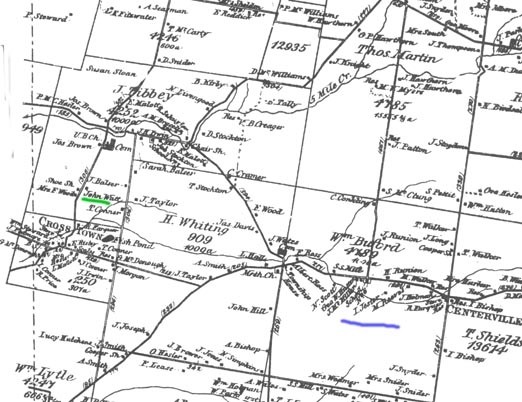In the winter of 1839, Noah bought 163 1/2 acres for $1011 at a sheriff's auction held for non-payment of taxes. This property was located on the east side of today's Bloomrose Road, a mile north of Crosstown. In the census of 1840 taken that summer, Noah is listed with 6 sons, and no wife, but in December of that year he married Lucinda White.
I find it revealing to note the neighbors of the subjects I'm looking at. This community of families regularly shared in social and religious activities, as well as the tasks of harvesting the crops, building the roads and bridges, and participating in local government matters. Relatives, both current and future can be found by looking within a horse-ride trip around the residence, or the nearest church. Some of the family names in the 1840 census for Sterling Township are Archibald McLain and his father Archibald Sr., who regularly served as Justice of the Peace, and John Lampkins, whom I presume is related to Lucinda {White} Conover's mother, Sarah Lampkins. Also, several members of the Malott family, John M and William Shotwell, several members of the Waits family, John Conner, Reuben Fight, Isaac Conner, Samuel Simonton, James Dorman, and William Hutton, all of whom at one time or another had land transactions with Noah.
In September of 1841, Noah sold two parcels of this land containing about 50 acres to Peter Conover. At this writing I do not know who this Peter is, he could be Noah's brother, but I'll update this when I can verify his identity.
On August 21, 1849, Noah's oldest son Henry died at age 21. Noah was the administrator for his estate, which consisted of his tool chest and a silver watch. Since he died before the 1850 census, which listed occupations, one can speculate on his occupation based on the contents of his tool chest: a stick howel, a block plane, a backing knife, a champening knife, a shape up knife, a hoop knife, a craze, and a hedding knife. His younger brother Thomas was listed in the census as a blacksmith, and other occupations of his neighbors then (besides farmer) were wagon maker, cooper, and shoemaker. Besides Noah, Lucinda's brother Bartlett C White purchased some of Henry's tools.
In the 1850 census, Noah's neighbors were James Conover, William Hutton, the Waits families, the Conner families, Samuel Conover (whom I've not placed yet), John Balsar, and several of the Malott family members. Noah and Lucinda's household listed a Lucinda McIntire, age 19. Lucinda's brother Bartlett married a Lydia McIntire, and her sister Anna married N. M. McIntire, so I suspect she was part of this family.
In 1853, son Thomas died. He was 21, and is buried in Price Cemetery, but I've learned nothing more about him.
In 1860, Noah bought ten acres of land from his neighbors, Ira and Melinda Conner. Noah's son Wesley was listed in the Conner's household in that summer's census (his occupation a cooper), but he was to die in September of that year at age 25.
Some of the folk that appear in the vicinity of Noah at the time of the 1860 census are several Waits families, Dormans, Malotts, Stewarts, Thomas Prall who was listed as a merchant, a few Conners families, George McDonough listed as a physician, Samuel Conover, James Conover (the son of Eliakim Conover who settled in Clermont with Noah's family when they arrived from New Jersey), and a few Watt families.
In 1865, Noah and Lucinda's oldest son, William Edward, married Sarah E Farquer, the daughter of Robert Farquer, Jr and his wife Almira Stewart who lived within easy walking distance of the Conover family. They settled in Marathon, Clermont County, which is quite close to Crosstown. William served in the Civil War, married when he was discharged, and died in 1913 of carbon monoxide poisoning from a gas stove; Sarah lived until 1931. They had 5 children: Rosa, Cora (who married Arthur Prall), Frank, Ida, and Almira.
That December of 1865, Noah sold 90 acres of land to John Watt. I'm still trying to determine all of the land transactions by Noah during this time, but this appears to be a sell-off of some of the Crosstown land on Bloomrose Road as he bought more land a short distance west of the Centerville area. It isn't obvious yet whether he actually changed his abode to the Centerville area or he bought better land there to farm and continued to live at Crosstown on a small plot until he moved to Warren County
An obvious tool to use to determine the answer to this question would the 1870 census, but alas, he is not to be found in the index of all of Ohio in 1870, and a line-by-line search of Sterling township in Brown County fails to show him or his family members. It's not unusual that a family would be missed during a census, but given Noah's position in the community, I find this quite odd. He held large tracts of land, frequently traded parcels with his neighbors, lived on commonly-traveled roads, his children attended school with the neighbors, and married some. He was certainly acquainted with the census takers. I continue to look for clues for where he and his family might have been on census day in 1870.
Here is a map from 1876 of Sterling Township in Brown County, Ohio. Clermont County is off to the left, the green line marks the location I believe Noah lived, and the blue line marks the area where he had land transactions in the later years.
For a bigger image, click on the map.
